Physical Address
304 North Cardinal St.
Dorchester Center, MA 02124
Physical Address
304 North Cardinal St.
Dorchester Center, MA 02124
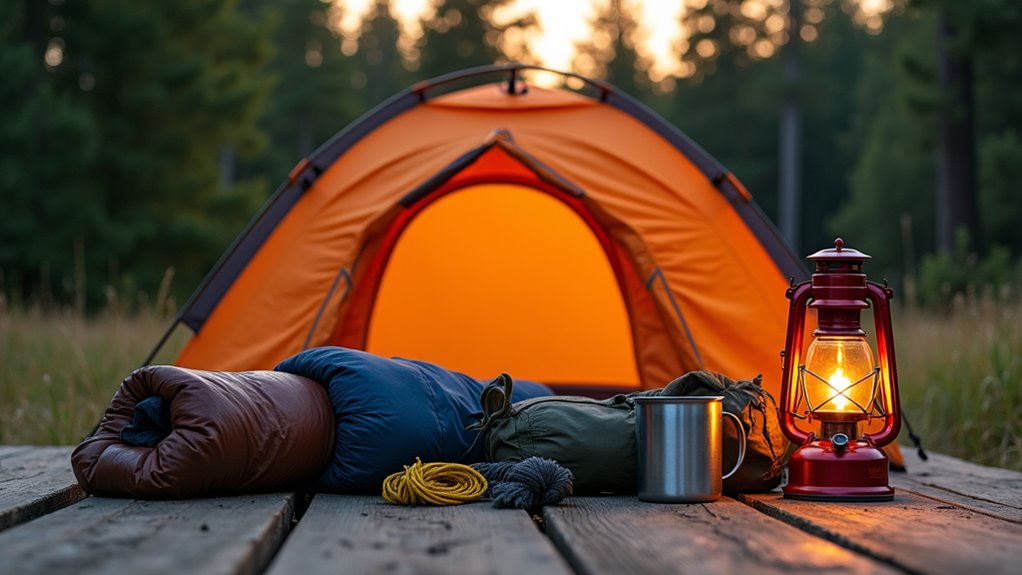
Outdoor adventures become easier when you master these 15 essential camping terms that separate novice campers from seasoned wilderness experts.
Whether you’re planning your first camping trip or you’ve been hitting the trails for years, you’ll encounter terms that might leave you scratching your head. From “batoning” to “cairns,” the outdoor world has its own vocabulary that can make or break your wilderness experience. Understanding these essential camping terms isn’t just about sounding knowledgeable around the campfire—it’s about staying safe, prepared, and confident when you’re miles from civilization and every decision matters.
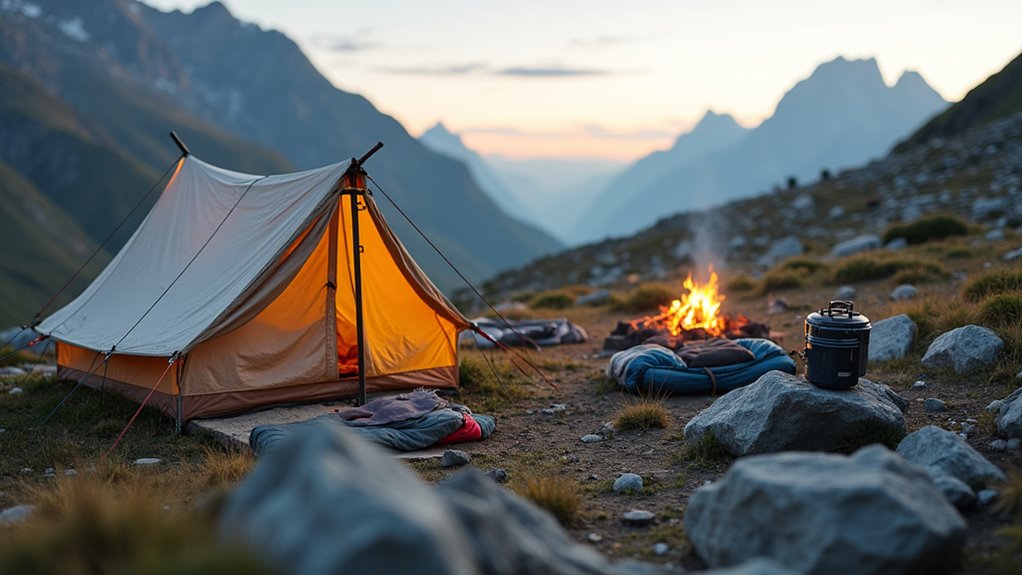
When you’re planning a multi-day outdoor adventure, your basecamp serves as the central hub where you’ll store gear, prepare meals, and rest between activities. You’ll typically establish your basecamp in a sheltered location with access to water and level ground for tents.
Think of it as your temporary home base—it’s where you’ll return each evening after day hikes or exploration.
Your basecamp becomes a familiar refuge where tired legs find rest and tomorrow’s adventures begin to take shape.
Choose your basecamp location carefully. Look for natural windbreaks like trees or rock formations, and avoid low-lying areas that might flood. You’ll want enough space for all your gear without crowding your sleeping area.
A good basecamp makes your entire trip more comfortable and organized, giving you a reliable starting point for each day’s adventures while keeping your essential supplies secure. Understanding essential camping terms like basecamp will help you communicate more effectively with fellow outdoor enthusiasts and better plan your adventures.
Where does true wilderness begin? The backcountry is where you’ll find your answer. It’s the remote, undeveloped areas far from roads, facilities, and crowds. You won’t find designated campsites, bathrooms, or water sources here.
When you’re venturing into backcountry, you’re entering self-reliant territory. You’ll need to carry everything on your back – shelter, food, water purification, and emergency supplies. Leave No Trace principles become critical since there’s no infrastructure to handle waste or disturbance.
Backcountry camping requires permits in most areas, advanced planning, and solid outdoor skills. Navigation, weather assessment, and risk management aren’t optional. The reward? Pristine landscapes, complete solitude, and the ultimate camping challenge. It’s where experienced campers test their limits.
Without restrooms available, you’ll need to master proper techniques for going to the bathroom in natural settings while following Leave No Trace guidelines.
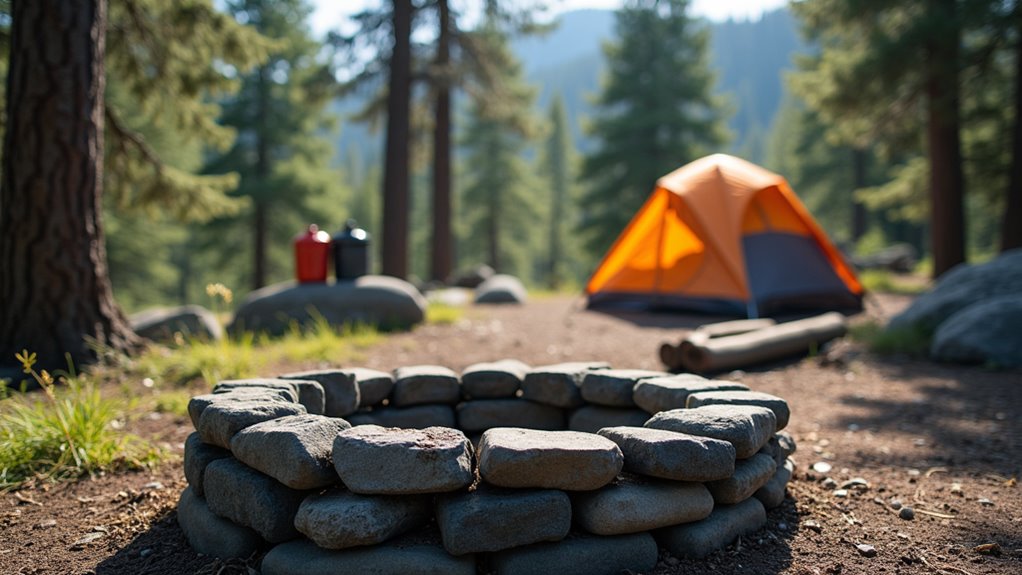
Unlike designated campgrounds with their numbered sites and amenities, dispersed camping lets you pitch your tent on undeveloped public lands without reservations or assigned spots. You’ll find these opportunities primarily on Forest Service and Bureau of Land Management properties, where you can camp for free while following specific guidelines.
This style of camping requires more self-sufficiency since you won’t have access to restrooms, water, or trash collection. You’ll need to pack everything in and pack everything out, leaving no trace of your visit.
Key dispersed camping principles include:
Many dispersed camping areas serve as excellent base camps for accessing world’s best hikes and remote trailheads.
How can you guarantee your outdoor adventures don’t harm the environment for future campers? Follow Leave No Trace principles, which guide responsible outdoor recreation through seven core guidelines.
Plan ahead and research regulations. Travel and camp on durable surfaces like established trails and campsites.
Research regulations beforehand and stick to established trails and designated campsites to minimize your environmental impact on fragile wilderness areas.
Dispose of waste properly by packing out all trash and burying human waste 6-8 inches deep.
Leave what you find—don’t take rocks, plants, or artifacts.
Minimize campfire impacts by using established fire rings and fully extinguishing flames.
Respect wildlife by observing from a distance and storing food securely.
Be considerate of other visitors by keeping noise levels down and yielding trail right-of-way.
These principles ensure camping areas remain pristine for everyone while protecting fragile ecosystems from permanent damage. Whether you’re tent camping or planning to rent an RV, these guidelines apply to all forms of outdoor recreation.
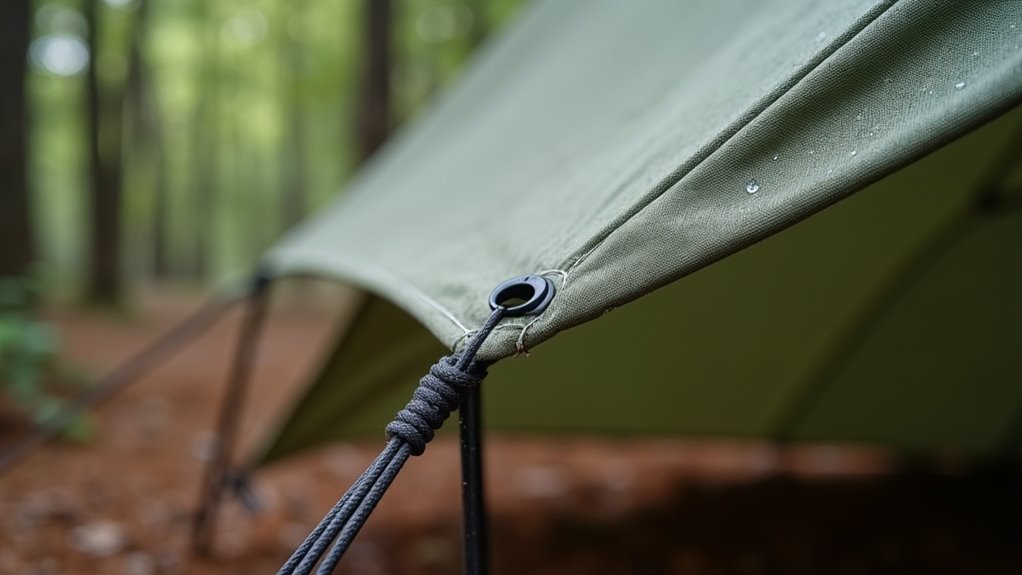
Whether you’re creating emergency shelter or protecting gear from rain, a tarp ranks among the most versatile pieces of camping equipment you can pack. This waterproof sheet transforms into countless configurations with proper rope and stakes.
You’ll find tarps invaluable for:
Choose lightweight, durable materials like ripstop nylon or polyethylene. Pack plenty of paracord and lightweight stakes for setup flexibility.
Master basic knots like the trucker’s hitch to maximize your tarp’s potential in any camping scenario. Following essential safety tips while setting up your tarp can help prevent accidents and ensure a more enjoyable outdoor experience.
When you’re battling gusty winds or securing shelter in challenging terrain, guy lines become your tent’s lifeline to stability. These adjustable cords attach to specific points on your tent or tarp and anchor to the ground using stakes or trees.
They’re essential for maintaining proper tension and preventing your shelter from collapsing or flapping violently.
Most tents come with guy lines pre-attached to reinforced loops called guy-out points. You’ll typically find them on rainfly corners and mid-panel locations.
The key is creating the right tension – tight enough for stability but not so tight that you stress the fabric.
Use reflective guy lines when possible, as they’re easier to spot at night and prevent dangerous trips.
Always pack extra cordage since guy lines can break when you need them most.
For jungle camping adventures, guy lines are particularly crucial as they help secure hammocks to trees when traditional ground tents aren’t suitable for the dense, uneven terrain.
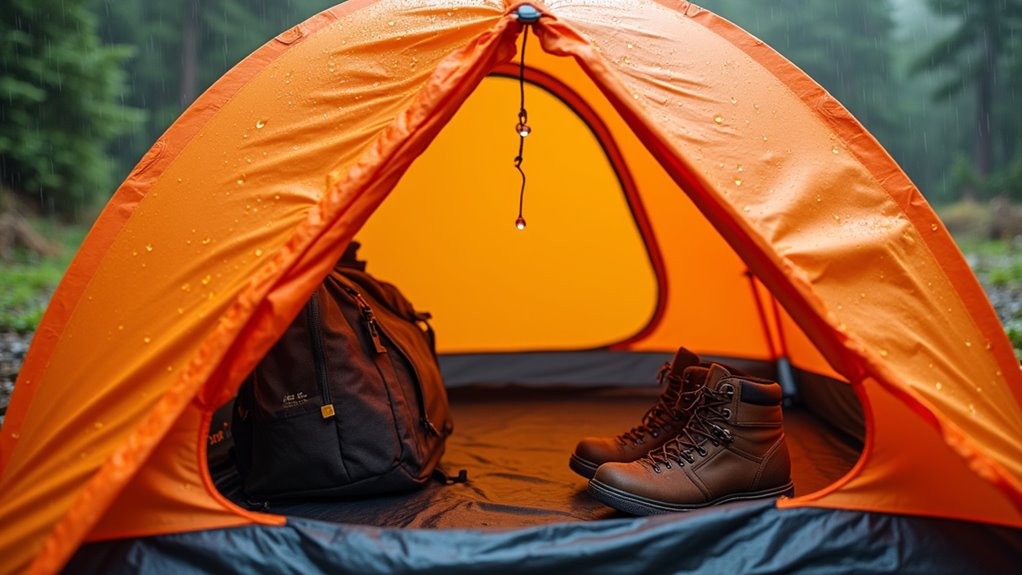
A vestibule acts as your tent’s mudroom, providing covered space outside the main sleeping area where you can store gear, cook meals, or change clothes without tracking dirt inside. This extended area keeps your sleeping quarters clean and organized while giving you flexibility during bad weather.
Most backpacking and family tents include vestibules, though sizes vary notably. You’ll find them invaluable for:
Choose tents with larger vestibules if you’re car camping or need extra storage space. For group camping situations, consider models like the Pegasus Tent that offer spacious vestibule areas to accommodate gear and activities for multiple campers.
Ground sheets create a protective barrier between your tent floor and the rough terrain beneath, extending your tent’s lifespan while improving comfort. You’ll place this waterproof layer directly on the ground before setting up your tent, shielding the floor from rocks, roots, and moisture that could cause punctures or tears.
Choose a ground sheet that’s slightly smaller than your tent’s footprint to prevent water from pooling between the layers during rain.
Many campers use lightweight tarps, specialized tent footprints, or even heavy-duty plastic sheeting as makeshift options.
Don’t skip this essential piece of gear – it’s much cheaper to replace a ground sheet than repair or replace your tent floor after damage from abrasive surfaces. Just like avoiding RV buying mistakes, taking time to properly protect your tent with a quality ground sheet will save you money and frustration in the long run.

Why does your tent need a second roof? That’s exactly what a rain fly provides – an additional waterproof layer that covers your tent’s main body. This essential piece of camping gear creates a protective barrier between you and the elements, ensuring you stay dry during unexpected downpours.
A rain fly offers several key benefits:
You’ll typically attach the rain fly using clips, poles, or guy lines. Most quality tents include a rain fly, but you can purchase aftermarket options for better coverage or replacement needs. Having an essential survival kit on hand ensures you’re prepared for any weather conditions that might test your rain fly’s effectiveness.
While setting up your shelter protects you from weather, protecting your food from wildlife requires different gear altogether. A bear canister is a hard-sided, cylindrical container designed to keep bears and other animals away from your food and scented items.
You’ll need to store all food, toiletries, trash, and anything with a scent inside this lockable container when camping in bear country.
These canisters feature a special locking mechanism that’s easy for humans to operate but impossible for bears to open with their claws and teeth.
You must place the canister at least 100 feet from your campsite and sleeping area.
Many national parks and wilderness areas require bear canisters, so check regulations before your trip.
Proper food storage becomes even more critical during hot-weather camping when increased temperatures can intensify food odors that attract wildlife.

After you’ve secured your food from wildlife, building a proper fire becomes your next priority for warmth and cooking.
Kindling refers to small, dry materials that catch fire easily and help shift from initial sparks to larger flames. You’ll need kindling that’s roughly pencil-thick to finger-thick in diameter.
Proper kindling bridges the gap between your initial spark and a roaring campfire – choose dry materials sized between pencil and finger thickness.
The best kindling materials include:
Always collect kindling before you need it, keeping it completely dry. Store extra kindling in your tent or under a tarp during wet weather.
Without proper kindling, even the best fire-starting skills won’t help you create sustainable flames for cooking or warmth. Just like choosing between renting or buying watercraft for fishing adventures, selecting the right kindling materials can make or break your outdoor experience.
What transforms a single spark into the foundation of your campfire? Tinder – the finest, most combustible material that catches fire instantly and burns hot enough to ignite kindling.
You’ll find natural tinder everywhere: dry grass, birch bark, pine needles, or shredded cedar bark work perfectly. Paper, dryer lint, and petroleum jelly-soaked cotton balls make excellent manufactured options. The key is size – tinder should be pencil-thin or smaller.
Keep your tinder bone-dry by storing it in waterproof containers or ziplock bags. When building your fire, create a loose nest that allows airflow. You don’t need much – a handful is plenty.
Teaching kids about fire safety and tinder preparation helps them develop essential camping skills while ensuring kids sleeping bags stay safely away from the fire area.
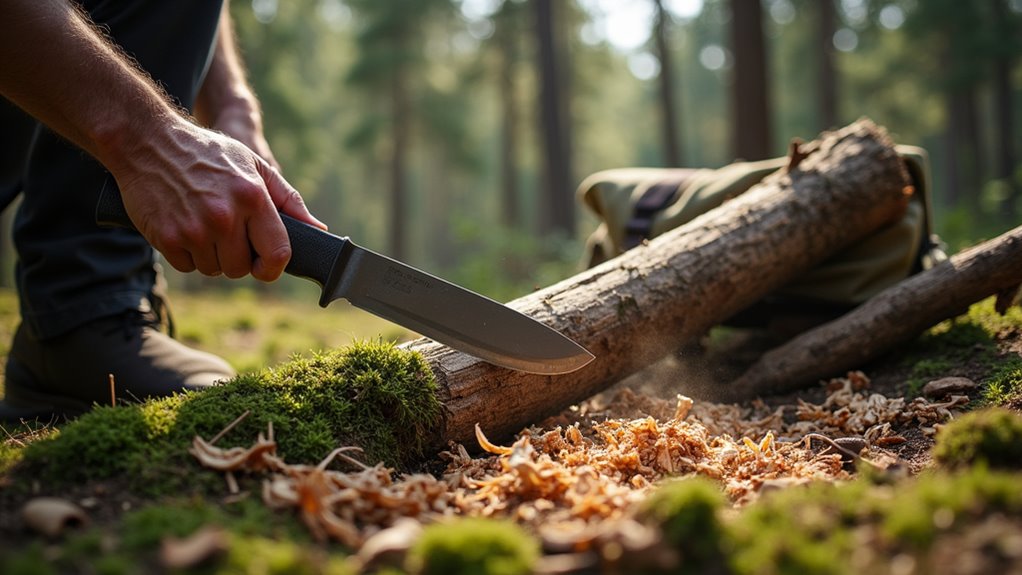
When you need to split wood but don’t have an axe, batoning becomes your go-to technique for processing firewood in the wilderness. You’ll use your knife as a wedge and strike the spine with a wooden baton to split logs along the grain.
Here’s what makes batoning effective:
Batoning transforms your knife into a powerful wood-splitting tool through leverage, control, safety, and versatility in wilderness situations.
Choose a sturdy stick as your baton and ensure your knife’s full tang construction. Start with smaller logs and work up to larger pieces as you develop technique and confidence. A quality camping knife designed for outdoor adventures will handle the repeated impacts of batoning while maintaining its edge and structural integrity.
Stacking rocks into small towers, you’ll create cairns to mark trails, signal direction changes, or identify important locations during your outdoor adventures. These stone markers have guided travelers for thousands of years across deserts, mountains, and remote wilderness areas.
You’ll find cairns most useful when natural landmarks are scarce or when fog obscures your path. Build them using flat, stable rocks with the largest stones as your base. Make each cairn tall enough to spot from a distance but sturdy enough to withstand weather.
Remember to follow Leave No Trace principles—only build cairns when necessary and dismantle unnecessary ones you encounter. Some parks prohibit cairn construction, so check local regulations first. Always rely on maps and compass rather than depending solely on these markers.
After a long day of trail navigation and cairn building, ensure you have quality camping sleeping pads to help you recover and recharge for the next day’s adventures.

How do you survive comfortably in the wilderness using only basic tools and natural resources? That’s bushcraft – the art of thriving outdoors through practical skills and knowledge. You’ll learn to work with nature rather than against it, developing self-reliance that transforms your camping experience.
Bushcraft transforms wilderness challenges into opportunities through practical skills, natural resourcefulness, and deep understanding of your outdoor environment.
Bushcraft encompasses fire-making, shelter construction, water purification, and food procurement using minimal equipment. You’ll master knife skills, understand local flora and fauna, and develop problem-solving abilities that keep you safe and comfortable.
Essential bushcraft skills include:
These foundational skills enhance your outdoor confidence immeasurably. Mastering bushcraft techniques helps first-time campers overcome their natural dread of venturing into unfamiliar outdoor environments.
You’ve mastered the sacred camping vocabulary – congratulations, you’re now fluent in wilderness speak! Armed with terms like “batoning” and “bushcraft,” you’ll sound like a seasoned outdoorsperson even if you’ve never left your backyard. Don’t worry if you forget half these words once you’re actually setting up camp in the dark – we won’t tell anyone you called your vestibule a “tent porch” instead.